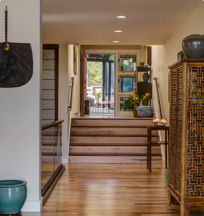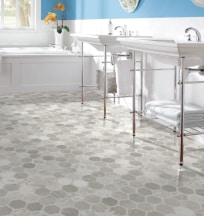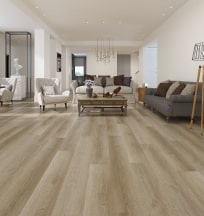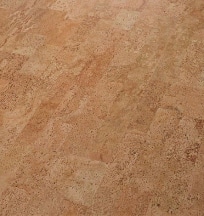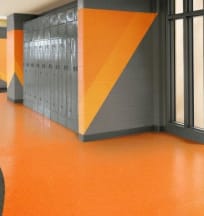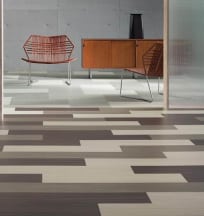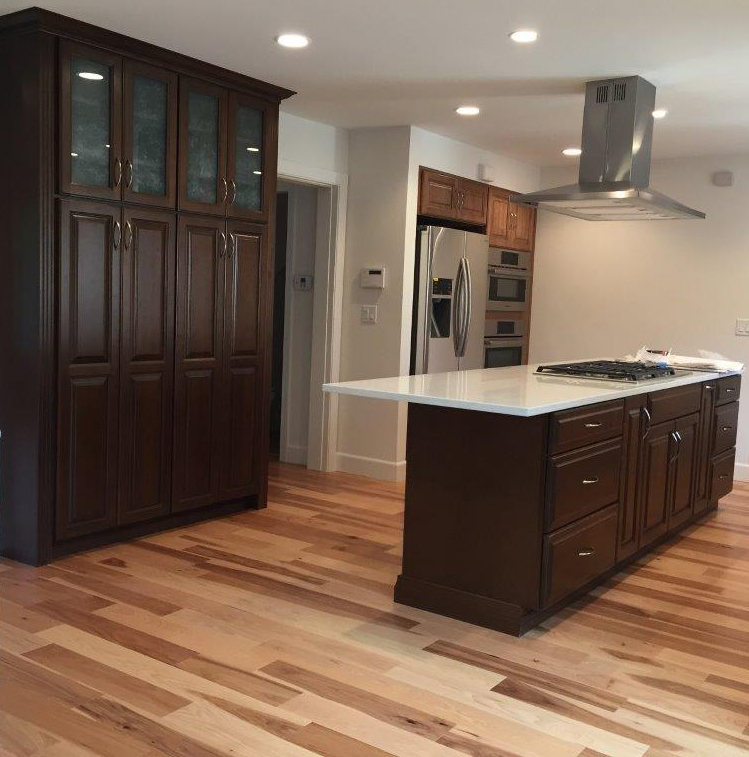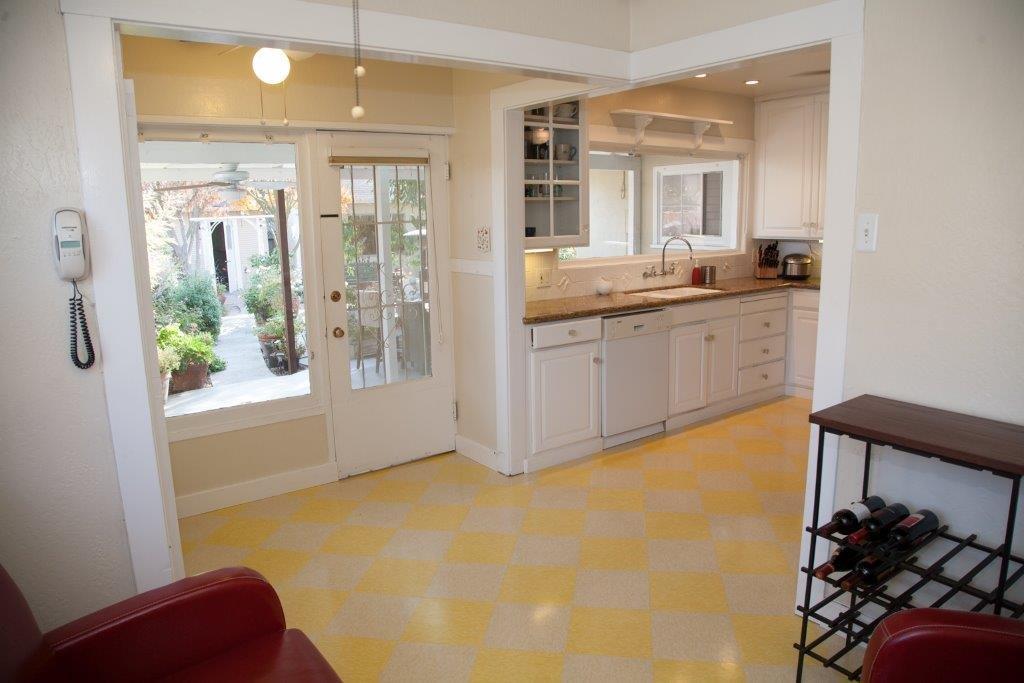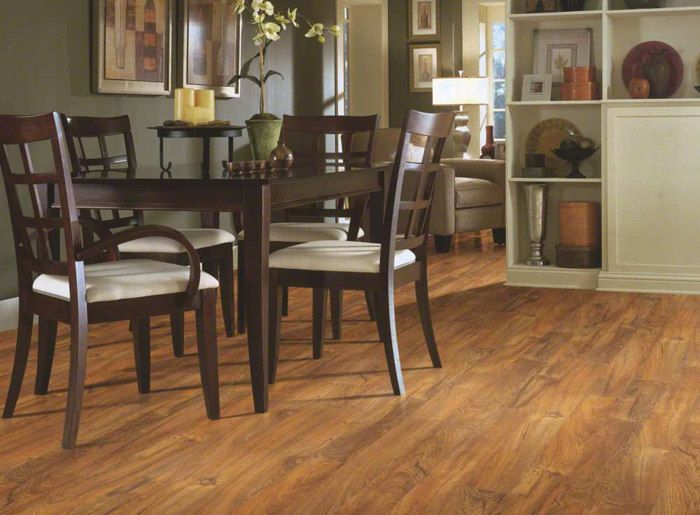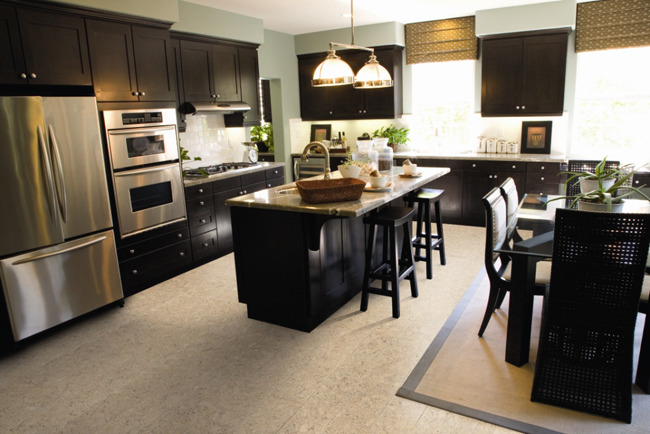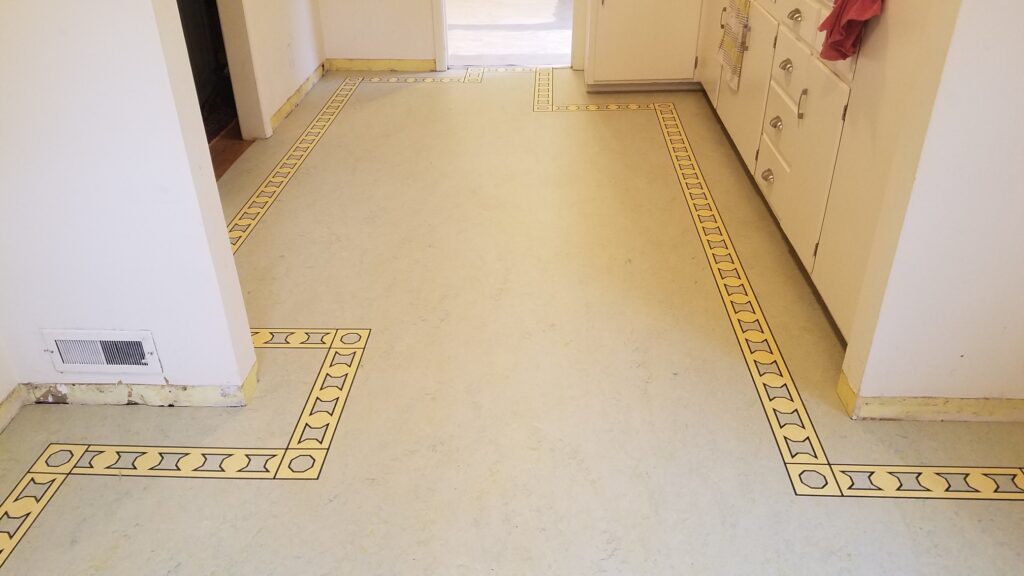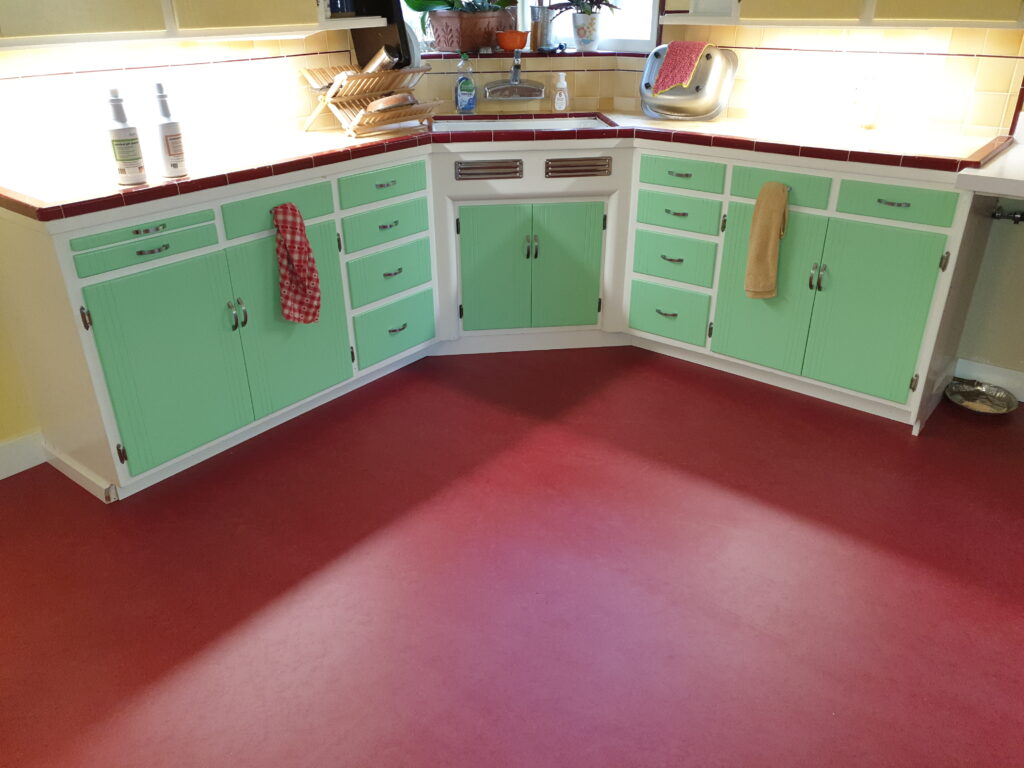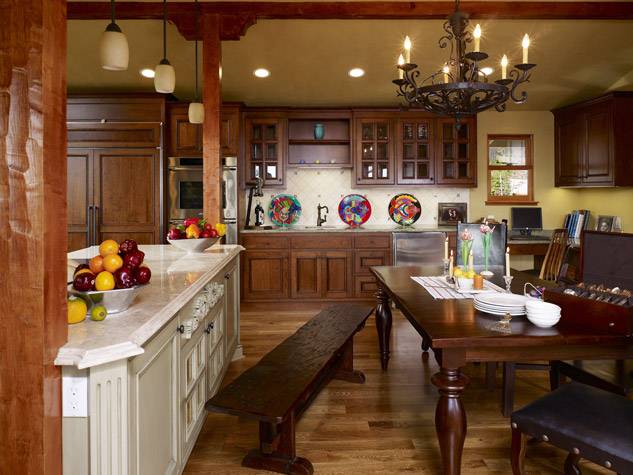Hardwood for Kitchens
Hardwood flooring is one of the most desirable kitchen options because of its hardiness and attractive, traditional look. Solid hardwood, while not waterproof, can be water-resistant if treated with the proper finish (a prefinished sealed hardwood is a good choice).
Hardwood can also be quite slippery, so a textured finish (hand-scraped, distressed/reclaimed wood) can help provide more traction and also cover up damage from kitchen wear and tear. Finally, select wood with a high Janka hardness rating (1500+), such as hickory, so it can withstand frequent use and drops while minimizing damage.
Pros of Hardwood
Durability: Hardwoods are well known for their durability, and when the installation is done correctly, they can last for decades. Hardwood with a high Janka value is resistant to scratches, stains, and dents, making it the best choice for kitchens that serve many people.
Aesthetic beauty: Hardwood comes in a range of colors and grain patterns.
- oak has knots & swirls, and ranges in color; between light beige to medium brown
- maples have a light to fine color with an even finer pattern
- cherry comes in a warm and reddish-brown color,
- hickory ranges between light blonde to dark brown coupled up with swirls, knots & burls
- mahogany is a deep reddish-brown with an even finer grain pattern.
Ease of maintenance: Hardwood is easy to clean and maintain. It only requires regular sweeping and once-in-a-while mopping with a mild detergent solution to keep the floor looking its best..
Resale value: Hardwood adds value to the home, and as such, typically boosts the home’s resale value.
Cons of Hardwood
Water damage: Hardwood is mainly susceptible to damage by water which causes swelling, warping, and discoloration, which could cause permanent damage to the kitchen floor.
Scratches and dents: Hardwood is susceptible to scratches and dents from heavy furniture when pushed or pulled against the floor.
Cost: Hardwood flooring is expensive when compared to other types of floors, such as laminate or tiles. The cost may vary depending on the hardwood type, finish, and installation method.
Vinyl & Luxury Vinyl Flooring for Kitchens
Vinyl flooring is a synthetic flooring material that is made by combining different layers of materials like PVC and felt to form a highly durable floor covering at an affordable price point.
Vinyl & luxury vinyl flooring for kitchens are other excellent choices to consider. They come in a plethora of color, pattern, and texture options. They can also be cut to achieve unique looks or patterns. You’ll see many initialisms for this type of floor – LVT, LVP, WPC, and SPC. They come in different sizes (Luxury vinyl tile/plank) and with different cores (what it’s made of – Wood Plastic Composite / Stone Plastic Composite).
WPC is mistakenly called Water Proof Core, even by experts, but it really is one of the best options for waterproof kitchen flooring that will protect from spills and water, so it is an appropriate mistake.
Today’s vinyl products are much more durable than the past, but they are still prone to scratching – something to consider for kitchens with heavy wear and tear. It’s also a good idea to keep fresh felt bumpers on kitchen stools or chairs. Keeping an extra box or more of new planks in storage is also important to replace any that may get damaged in the future.
Modern vinyl coverings can also look so close to real wood, hardly anyone will be able to tell the difference. In fact, the front of our showroom has LVP in a herringbone layout and most customers think it’s wood!
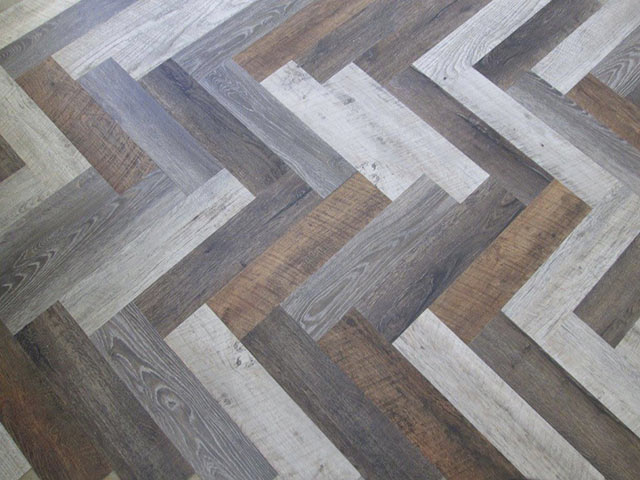
Slaughterbeck Floors Showroom – Luxury Vinyl Planks in Herringbone Pattern
Pros of Vinyl Flooring
Durability: Vinyl flooring is very durable, making it one of the best flooring options for high-traffic kitchens. It can withstand massive amounts of pressure and resistance without getting scratches or dents. Vinyl can last up to 25 years with proper care & maintenance.
Affordability: Vinyl flooring is relatively less expensive to buy and install than hardwood, tiles, and stone flooring.
Ease of Maintenance: Vinyl floors are easy to clean and maintain. They can be swept and vacuumed regularly without the risk of wearing out.
Availability in various styles: Vinyl comes in various styles, patterns, and a range of colors and textures to choose from.
Waterproof: Vinyl floors are waterproof, making them an excellent flooring option for kitchens.
Cons of Vinyl Flooring
Not environmentally friendly: Vinyl floors are made of synthetic and non-biodegradable materials, and thus it is not the best option.
Lacks durability compared to kitchen flooring materials: While resistant to scratches & dents, vinyl flooring is not as durable as tile or hardwood and may be required to be replaced from time to time.
Fading: Some vinyl floors are prone to fading when cleaned regularly.
Contains toxins: Vinyl floors may contain toxins such as Phthalates that can pose a serious health risk to individuals.
Laminate Flooring for Kitchens
Laminate flooring is a synthetic flooring material designed to resemble natural materials like hardwood, stone, or tile.
It is made up of several layers that are fused together using a lamination process, which gives the flooring its strength, durability, and resistance to wear & tear.
Pros of Laminate Flooring
Easy installation: Installation design ranges from simple DIY to complex installation procedures that require the services of an engineer.
Affordability: Laminate flooring is generally less expensive when compared to hardwood & tile; therefore, it is a budget-friendly offer.
Ease of maintenance: Laminate flooring is easy to clean and maintain as it only requires regular sweeping & vacuuming.
Variety of styles: Laminate flooring is available in different types, such as plastic laminate, engineering wood laminate, and natural wood.
Cons of Laminate Flooring
Can be slippery: Laminate flooring tends to slide when wet, which can be dangerous in the kitchen.
Can be noisy: Laminate flooring releases irritating sounds when walked on with hard-soled shoes.
Prone to damage by water: Prolonged exposures to wetness could also result in floor warping.
Not long-lasting when compared to hardwood: Laminate flooring may wear and tear faster than other flooring techniques such as hardwoods and tiles.
Concrete Flooring for Kitchens
Concrete flooring involves pouring a slab and an overlay, followed by polishing and a colorizing treatment that gives the floor the color and texture it deserves. A well-done concrete floor could last as long as the house exists. Concrete floors also allow you to choose the color that seems best for you.
Pros of Concrete Flooring
Affordability: Concrete floors may cost between $2-$6 per square foot for the basic design, $7-$14 for the mid-range design, and $15-$30 per square foot for the high-end design.
Durable: Concrete flooring can last as long as the kitchen exists because of the firm slab and overlay that can withstand high pressure and force.
Easy to maintain: Concrete flooring requires to be wiped out with a mild detergent, and it becomes sparkling clean.
Design flexibility: Concrete flooring is available depending on the owner’s budget, taste, and preferences.
Cons of Concrete Flooring
Hard and cold: Concrete floors are tough because they contain a layer of a dry slab that may be uncomfortable standing on for a longer period.
Susceptible to moisture: Concrete flooring becomes damp when exposed to moisture, destroying its original color and texture.
Slipper: When wet, concrete floors tend to be slippery due to the polishing which makes its texture extremely fine.
Bamboo Flooring for Kitchens
Bamboo flooring is an efficient and eco-friendly flooring technique. Bamboo flooring exists in two varieties: solid bamboo flooring and engineered bamboo flooring.
Before installation, confirm that the floor is flat, level, and dry to avoid damages once it is laid. Bamboo flooring is also compatible with underfloor heating since they are dimensionally stable. It is also available in two main finishes, that is, Satin-matt lacquers and anti-slip lacquers.
Pros of Bamboo Flooring
Availability in different styles: Bamboo flooring exists in three main styles, that is, horizontal, vertical, and strand woven. Horizontal bamboo has wider grains on the surface. Vertical bamboo has thinner grains on the surface, while strand woven has random grains on its surface.
Variety of colors: Bamboo flooring is available in a variety of colors that may perfectly blend with your kitchen furniture. It is available in its natural color (pale, golden tone), carbonized effect (darker tone), and a rustic effect (traditional look)
Durability: Bamboo flooring is highly durable and can sustain the high human traffic that is always consistent in kitchens.
Eco-friendly: Bamboo flooring is eco-friendly due to the availability of bamboo, and the rate of restoration is greater than the rate of replenishment,
Compatible with underfloor heating: Bamboo flooring is ideal in kitchen settings because of the heat that it contains whenever there is excess heat in the room.
Cons of Bamboo Flooring
Susceptibility to damage by water: Bamboo flooring is considered more water resistant than traditional hardwood, but it may be susceptible to damage by water whenever it is not adequately maintained, making it warp or buckle.
Vulnerable to scratches: Bamboo flooring is highly susceptible to scratches caused by the push or pull of sharp objects against the surface. This is a great concern for a kitchen since it will limit the movement of different furniture.
Can fade over time: Bamboo may fade over time due to exposure to direct sunlight, which may affect the overall outlook of the flooring.
Cork Flooring for Kitchens
Cork flooring involves using the bark of the cork oak tree, which is ground and processed into sheets and baked to produce tiles. Cork floors are commonly used in kitchens because they are soft, sound absorbing, and green.
However, they do quickly fade when exposed to the sun. Cork flooring is available in different forms that are made with granulated cork mixed with resin binders.
Pros of Cork Flooring
Eco-friendly: Cork flooring is made from the bark of a tree which is harvested without harming the tree, making it sustainable and eco-friendly.
Comfortable and soft: Cork flooring is naturally soft and comfortable to stand on for a longer period, which fits a kitchen.
Easy maintenance: Cork can easily be maintained by cleaning it with damp clothing, making it look new.
Insulating properties: Cork flooring has natural insulating capabilities, keeping the kitchen warmer even during the cold season.
Durability: Cork flooring can withstand heavy foot traffic, which makes it suitable for a busy kitchen.
Cons of Cork Flooring
Susceptible to damage by water: While cork flooring is water resistant, it is not fully waterproof. Thus prolonged exposure is likely to cause warping and buckling.
Scratches and dents: Cork flooring is not as hard as concrete flooring and is, therefore, vulnerable to scratches and dents.
High cost: The price for cork flooring goes for about $9.50, which makes it more expensive when compared to other flooring methods.
Limited Color Options: Only a few color options are available, making one color choice monotonous.
Linoleum Flooring for Kitchens
Lineloum is a classic flooring material, with beginnings in 1855. The story is that an English inventor named Frederick Walton stumbled upon a can of oil paint that had become oxidized, and the linseed oil separated to the top. After several unsuccessful attempts of using it as varnish, he tried combining the dried bits of goop with cork dust, sticky gum, and pigment, then rolling it out into sheets backed by cotton cloth. The experiment was successful, and he named the product linoleum – a combination of the Latin words for oil and flax.
Linoleum was warm and noiseless, which gave it an advantage over wood and marble. It was also waterproof, flexible, and durable, making it superior to ‘floorcloths’ used at the time, which were thick, painted-on pieces of fabric. Another huge selling point was that it could be mixed and re-mixed into beautiful patterns.
However, by the mid-1900s, linoleum was so ubiquitous that it started to lose its popularity, being seen as tacky and cheap. Companies began marketing other flooring materials, like vinyl, which was more affordable and didn’t require wax to stay shiny.
And for a long time, it stayed out of fashion. Until recently, when linoleum made a comeback in trendy cafes, hotels, shops, and homes for many of the same reasons it’s a great choice for kitchen floors.
Pros of Linoleum Flooring
Durability: natural materials such as linseed oil, wood flour, & cork dust allow linoleum flooring to last for many years, making it one of the best flooring options for kitchens.
Cost Effective: While various factors will contribute to a specific job, typically linoleum will end up being one of the most cost-effective options over time if taken care of properly.
Eco-Friendly: in addition to being made from natural, renewable materials, linoleum is also free of harmful volatile organic compounds which can pollute the air in your home.
Customizable: Linoleum is available in many different pre-made patterns and can even have unique designs & pigments incorporated to match existing decor.
Cons of Linoleum Flooring
Susceptible to Sun Damage: Linoleum may change color if exposed to direct sunlight over extended periods of time.
Installation Odor: Freshly installed linoleum flooring has a particular odor to it, but this will dissipate within a few days with proper ventilation.
Unsealed Linoleum Requires Maintenance: If the linoleum flooring is not sealed it will require periodic polishing to maintain its appearance and protect it from wear & tear.
Susceptible to Moisture: linoleum flooring can absorb spills and liquids, and if it’s not installed correctly, it can be ruined by water damage. However, a UV-cured finish can be added to improve its water-resistant qualities.
Marmoleum Flooring for Kitchens
Marmoleum is a brand of linoleum flooring that is manufactured by Swiss company Forbo Flooring Systems, a global leader in the flooring industry.
There are three forms of Marmoleum flooring: sheet, tile, and click.
Marmoleum Sheet has the largest variety of colors and designs. It comes as a large roll measuring 6½ feet wide, and however long you want it. Due to their bulkiness, Marmoleum sheets are mainly installed by professionals.
Marmoleum tiles are slightly more rigid due to a difference in backing materials. The sheets have jute backing, while marmoleum tiles have HDF (high-density fibreboard) backing. Marmoleum tiles have fewer color options, but allow you to create patterns. They are also easier for beginners to install than large Marmoleum rolls.
The newest and most popular version of Marmoleum is Marmoleum Click. These tiles have a clicking mechanism, enabling you to quickly and easily install them by snapping onto each other. Marmoleum click tiles are mounted onto a stiff board backing. The stiffness makes them suitable for installation on uneven floors since the unevenness won’t transfer to the tiles. While Marmoleum Click is a more DIY-friendly option, but it doesn’t have as many color & design options as the tiles or sheets.
With sheet and tile marmoleum, the subfloor has to be leveled to prevent bumps and depressions from showing through. Marmoulem is a brand of linoleum flooring, so they share the same pros and cons.
Tile Flooring for Kitchens
Tile flooring is a common method of flooring that is used in most kitchens. It is available in two forms, ceramic and porcelain. Ceramic tile is less durable than porcelain tile but less expensive and may have an added visual effect. Porcelain tiles have finer clay that is packed under high pressures and temperatures. Tile size for the kitchen may range between 2-12 inches. Tiles are classified based on a hardness rating scale, which ranges from Class I to Class V, with Class V being the most suitable for kitchen use.
Pros of Tile Flooring
Durable: Porcelain tiles are waterproof, while ceramic tiles are porous. This variation makes you choose between the two because both rarely crack or chip.
Easy to maintain: Unlike other flooring techniques, tiles are easy to clean and only require to be wiped with a wet mop and packed with a mild detergent to keep them extra clean.
Affordable: Ceramic and porcelain tiles may range between $1 per square foot to $9 per square foot, making it highly affordable.
Cons of Tile Flooring
Expensive installation costs: Due to it’s difficulty of installation, tile is the most costly to install, laborwise.
Tough to install: The process of cutting and installing tiles may be challenging and tedious, requiring a specialist.
Cold: Tile is a poor conductor of heat, so homeowners would need to install radiant floor heating.
Use of grout: If grout sealer is not used during the process of installations, the grout lines may be prone to stains which makes them untidy.
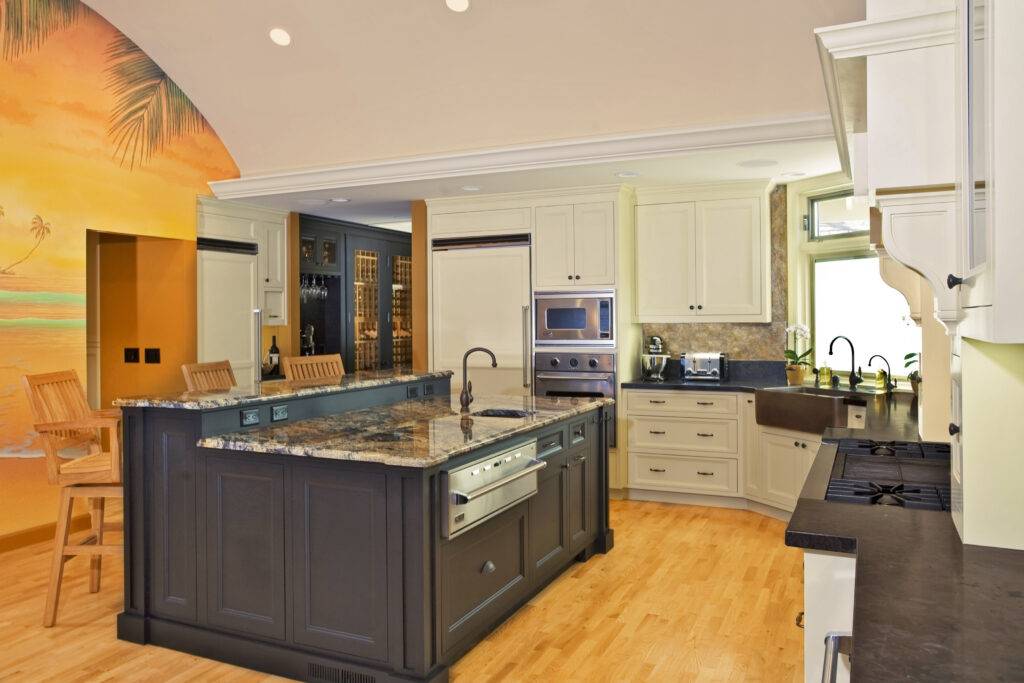 NARI Award-Winning Kitchen with Hardwood Flooring installed by us
NARI Award-Winning Kitchen with Hardwood Flooring installed by us
